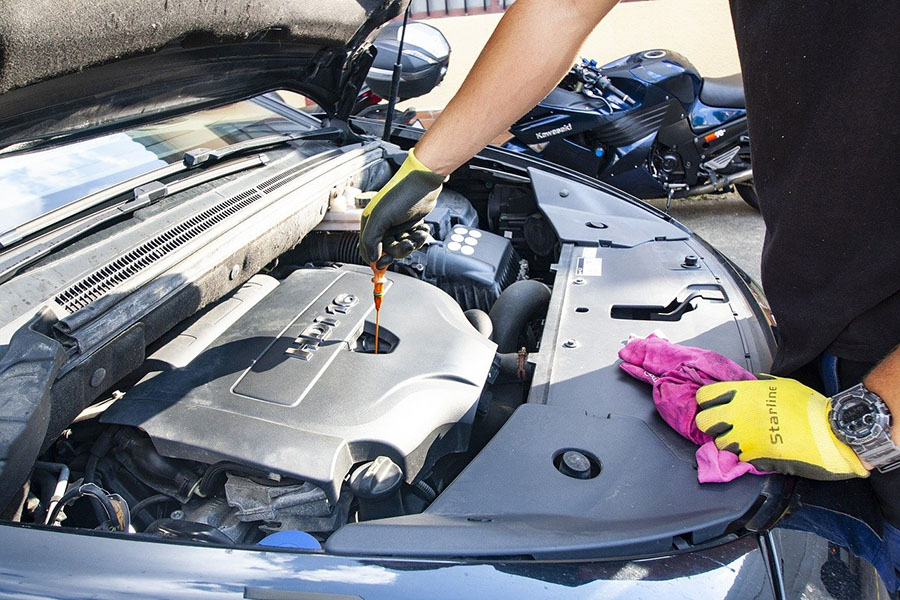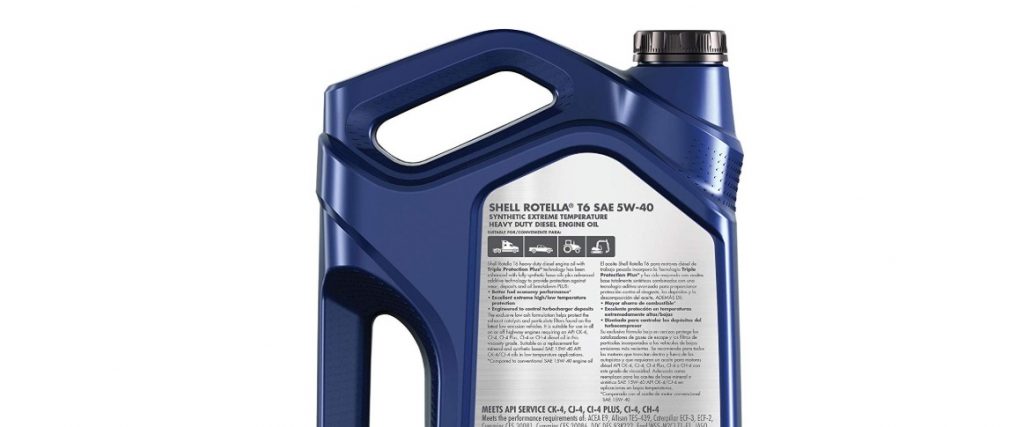What happens if you forget to change your oil on time? Its a simple question with a straightforward answer, but what if we ask; how harmful will it be for engine if you fail to change oil on schedule? Suddenly, it becomes a more complicated question that requires a more detailed explanation.

Oil viscosity & oxidation
Viscosity rating
Viscosity rating of an oil is its most important attribute. If you take a look at a bottle of oil it may have something like 10w40 printed on it. That number is telling you its viscosity rating. The 10w is the viscosity rating when the oil is cold, the W stands for winter. The number 40 is indicating oil viscosity when it is hot.
Why oxidation occurs?
Typically, the viscosity of oil will stay the same throughout its useful life, but with the passage of time as the oil is used, it oxidizes. The oxidation develops due to heat, oxygen, pressure and the overall environment. So as oxidation happens, eventually, its viscosity starts to increase.
There are numerous factors contributing to the increase in viscosity, part of it being the oxidation and the other due to volatile elements within the oil. The lighter elements that are a bit more thin start to burn off.
As time goes by, contaminants within the oil begin to increase. The combination of all of these factors result in the viscosity eventually going up as the oil within your engine ages and is used for longer period of time.
How long will it take for oil to become viscous?
The timeline of when it will happen can’t be accurately predicted, as it depends on the type of oil and even the engine itself. But there will come a time when the viscosity starts to really go upwards, that’s where lies the risk of damage, because of improper flow of oil within the engine. And without that flow, you’re not going to have proper protection which will result in wear of engine.
Why does engine burn oil?
Another thing to worry about is oil consumption within an engine. All engines burn oil, in newer engines the oil consumption is significantly low, but as engines age the consumption increases.
Mainly, there are three sources for oil going into the combustion chamber and then burning off. The first one being the valve guides; as your intake valve is moving up and down you have oil lubricating that interaction, and that oil can leak down to intake value, and then ultimately find its way into the engine where it is burned in the combustion chamber.
There is also positive crankcase ventilation system. Within the engine there is buildup of high pressure beneath the pistons and that high pressure needs somewhere to go, so the ventilation system allows this pressure to be diverted back to your intake. Also, some oil mist develops within your crankcase which can then be diverted back into your intake resulting in oil mist burning in your engine.
The cylinder walls also gets lubricated with piston cylinder interaction. So this makes the third location where the oil will be interacting with the combustion chamber and thus burning off.
What are the risks of oil burning in engine?
Obviously the worst outcome can be burning of literally all the oil, resulting in zero lubrication for the engine. When this happens, it will get too hot and a lot of wear will occur due to high friction from metal on metal interaction, and it’s going to be disastrous for the engine.
So we know the worst case scenario, but what will happen if you’re just a little bit late on your oil change? In that case, you’re just going to have less overall oil within the engine, which poses a problem. Because with the decrease in oil, the remaining oil is going to have to work even harder to protect your engine. Due to less oil, oxidation process will accelerate leading to more negative outcomes.
Oil contamination
With burning of oil, you leave behind contaminants, particularly those dangerous metal contaminants which could be from the engine itself. They will increase in number within the oil leading to additional wear. So it starts to kind of spiral out of control and suddenly spikes in viscosity, where the oil is now oxidizing significantly quicker, it’s getting thicker and the contaminants are increasing rapidly.
Oil Additives
Modern motor oils are now more complicated than ever, as they include all kinds of different additives which play a big role for engine’s health. This is not a complete list of additives used in oil industry, but we are going to have a look at most popular ones found in top brand name motor oils.

So, this is the list of different additives, what’s their purpose and what will be the consequence of using oil for far too long in relation to these additives.
Antioxidants
Antioxidants and oxidation is the main cause of oil degradation. These are very important in lowering the rate of oxidation, so waiting too long for oil change will result in the oil breaking down more, losing its potency and increasing wear within your engine.
Anti-wear (i.e. Zinc)
Anti-wear additives, for example zinc, reacts with rough surfaces to create a barrier in order to reduce the friction and amount of wear that happens over time. As you start to use up that zinc and remove those barriers, it becomes less effective increasing wear.
Detergents
Detergents are very important for preventing corrosion and sludge build-up within the engine. So over time as that sludge starts to build up and your detergents lose their effectiveness, the sludge can get within passageways reducing oil flow. Lesser oil means less protection, so you’re increasing friction and the risk of engine degradation. You can also have excessive carbon deposits form within the engine.
Dispersants
A dispersant, also known as dispersing agent or a plasticizer, or a superplasticizer is either a non-surface active polymer or a surface-active substance added to a mixture, to improve the separation of particles and to prevent clumping.
Dispersants just circulates within the engine, sometimes they get filtered out, but mostly they just continues to circulate within the engine and don’t attach to anything and don’t form any harmful carbon deposits.
So, the longer you wait for oil change, the more of these deposit precursors are going to be held within your engine. Those deposits will just float around in your oil, waiting to attach to something and never getting removed.
When you see dark oil coming out while draining used oil, its actually a good thing. It means you’re taking out all of those contaminants when you change the oil. If you don’t want those contaminants in there forever, you need to change your oil on time.
Viscosity modifiers
The purpose of these is to increase viscosity of oil at higher temperatures, improving its viscosity index. This prevents the oil from becoming too thin at high temperature.
At higher temperatures these modifiers start to expand and as they expand they thicken the oil. They breakdown with overuse, and will eventually start to decrease the viscosity of oil at engine’s operating temperature. You may initially see a drop in viscosity because as they expand out, they’re susceptible to being sheared split into different parts and then you have a decrease in viscosity. After they are no longer effective, finally oxidation is going to play a bolder role and the viscosity is going to increase.
Pour point depressants
Pour point depressants are used to allow the use of petroleum based mineral oils at lower temperatures. The lowest temperature at which a fuel or oil will pour is called a pour point.
They are very important for improving low-temperature flow. If you live in a cold area, it’s almost necessary to have pour point depressants for good startup flow. As you may already know, it critical to make sure that oil is flowing smoothly within the engine during startup which prevents wear.
So when pour point depressants start to wear out, the oil becomes too thick at startup and hindering the smooth circulation of oil within the engine.
Defoamers
A defoamer or an anti-foaming agent is a chemical additive that reduces and hinders the formation of foam in oil.
If you look within the crankcase of engine, there is a crankshaft, and it rotates around, and it splashes the oil all over the place. Due to this splashing, it can create a foam and start to create bubbles, so the purpose of defoamers is to reduce that air and oil bubble surface tension. Those bubbles pop with this additive and you don’t create a foam within the engine.
If you delay the oil change and the anti-foaming agent becomes ineffective, your oil will foam up. It’s going to reduce your oil pressure, and it can cause cavitation, which will reduce protection, resulting in additional wear.
Lab testing
So, how can we really be sure when to change oil? How can we check if we have waited too long and there is possibility of engine damage?
For our convenience, there are labs where you can get the oil tested. You take a sample of oil from your engine and submit it to a lab. They’ll examine it based on its viscosity, looking at metals or contaminants, and then they will give you the report which will tell the condition of the oil.









